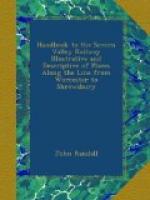We glanced in passing at some few features which could scarcely fail to attract the attention of the tourist, and a brief notice only of others will be needed for the geologist. In ascending the river we descend, geologically speaking, from an upper to a lower series of rocks, which rocks, in many instances, are covered over by fluviatile and marine deposits of sand and gravel, containing shells of fish inhabiting our modern seas. These show how recently the sea must have retired from a surface so covered with its remains; whilst their position low down in the valley, and but a little way above the present bed of the Severn, proves how much more recently the arm of the sea, known as the Severn Sraits, must have been succeeded by the river. The best places for collecting these remains along the railway will be found to be in embankments and cuttings near Buildwas and Coalbrookdale, the latter having yielded as many as twenty-two distinct species. In cuttings along the railway, and in their immediate vicinity, will also be found sections of rocks, from the variegated marls of the New Red Sandstone, of the Mesozoic, to the silurians, of the Palaeozoic, or Primary Formations. The coal measures of Coalbrookdale, with their alternating beds of coal, clay, and iron ore, are rich in specimens of the fauna and flora of the carboniferous age; the best places for discovering them being the spoil banks of the mines, where shale, and ironstone nodules, will be found the most productive. One of the richest beds yielding fossils is the Penneystone, which may be seen on the surface near Coalbrookdale and Ketley; remains of the Megalicthys, Gyracanthus, and Holoptychus being occasionally found there, whilst Conularias, Nautili, Spirifers aviculus, Bellerophons, and others are numerous. The sand rock overlying it contains Calamites, Lepidodendrons, Ulodendrons, Sigillarias, &c., &c. Benthall Edge and Lincoln Hill yield characteristic fossils of the Wenlock limestone and Wenlock shales in great numbers and variety, corals being most abundant. Between the Severn and the Acton Burnell hills fossils of the Caradoc may be found in drift, in old walls by the wayside, and in strata dipping praidly beneath the Wenlock shales.
BOTANY OF THE DISTRICT.
In shallow portions of the Severn, we have several varieties of the River Crowfoot (Ranunculus fluitans), which, with their long slender stems and pure white blossoms, form a conspicuous feature; also the Canadian Water-weed (Anacharis alsinastrum), which has found its way as high up as Shrewsbury. In marshy flats bordering on the river, are found the Yellow Flag (Iris pseud-acorus), the Water-dock, (Rumex Hydrolapathum), the Water Drop-wort, Soap-wort, Frog-bit-water-lily, and the creeping Yellow Cress; whilst the little Lily of the Valley, the Giant Bell-flower, the Spreading Bell-flower, the rare Reed Fescue-grass, and the tall, handsome Fox-glove, which,




